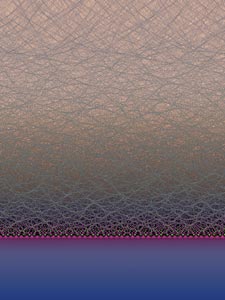The Fabric of the Cosmos: Space, Time and the Texture of Reality
Brian Greene
2004 Allen Lane/Knopf 512pp £25.00/$28.95hb
The Copenhagen interpretation of quantum mechanics, as laid down by Niels Bohr in the 1930s, has survived intact despite the thousands of experimental tests that have since been performed. Granted, it flies in the face of common sense, stating as it does that you cannot predict with certainty the outcome of any experiment, you can only assign a probability. You cannot simultaneously know the position of a particle and also its velocity. By determining the state of one photon here on Earth, you fix the state of its entangled partner on Alpha Centauri – an action-at-a-distance effect that Einstein called “spooky”.
Yet if Bohr were alive today, he would note with satisfaction that all the developments of 20th-century physics – from the Standard Model of particle physics, superconductivity, quantum computing and teleportation to the inflationary model of Big Bang cosmology – have come about without the need to change his interpretation by one iota.
Consequently, theorists fall into two camps. There are the hand-wringers who constantly worry about the quantum-measurement problem, asking “What does it all mean?”. And then there are the rest of us, who, preferring our angstroms without the angst, have a hard time seeing exactly what the “problem” is. If it ain’t broke, don’t fix it.
It was with some scepticism, therefore, that I learned that superstring theorist Brian Greene – author of the phenomenal best-seller and accompanying TV mini-series The Elegant Universe – was planning a sequel devoted to the interpretational problems of quantum mechanics. Could he fill a book with a non-problem? Would this not just be a potboiler, designed to justify the extravagant royalty advances? Would The Fabric of the Cosmos be much different from The Fabric of Reality by David Deutsch – a book also devoted to quantum measurement?
Well, how wrong can you get? The Fabric of the Cosmos is a profoundly original contribution to popular understanding not just of quantum theory, but of space-time, cosmology, the “arrow of time”, unification and the modern view of physical reality. Greene’s writing skills in explaining abstract ideas in simple terms have, if anything, got even better. His treatment of superstrings, extra dimensions and even more speculative ideas, such as multiple universes and time travel, are all grounded in sound scientific principles.
Greene recalls that his mother – a non-scientist – could read only a few pages of The Elegant Universe before getting a headache, but The Fabric of the Cosmos takes no prisoners in the difficulty of the subject matter it attempts to convey to the layreader. Take Bell’s theorem on hidden variables and the Einstein-Podolsky-Rosen paradox, for example, to which pages 104 to 112 are devoted. These quantum-mechanical conundra are not for the faint-hearted. Yet Greene does not shy away from proving the theorem using “reasoning less sophisticated than working out the odds in a craps game”. Even his mother could work her way through it, although Greene provides a headache-saving opt-out. “Depending on your taste for detail,” he writes, “there may come a point when you just want the punchline. If this happens, feel free to jump to page 112.”
The arrow of time is a theme that is revisited on several occasions throughout the book. Through relativity, quantum mechanics, thermodynamics, black holes, cosmology and an 11D extension of string theory known as “M-theory”, the reader gains an ever more sophisticated take on the basic puzzle: if the laws of nature do not distinguish between past and future, why are eggs seen to break but broken eggs never seen to recombine?
Saying that the universe started out in a state of low entropy takes the problem back to the Big Bang, but hardly provides an explanation. Although Greene makes the case that inflationary models of cosmology may provide the missing logic, this seems to be a paradox the punchline of which cannot yet be jumped to.
And in contrast to some other popular expositions of superstrings, Greene does not promote the now discredited view – advocated by many theorists between the 1984 superstring revolution and the 1995 M-theory revolution – that 10D superstrings are the be-all and end-all of fundamental physics. He concedes that there are no superstrings in 11 space-time dimensions. If you want to go beyond 10 dimensions to 11 – as we now know you must – then you must go beyond string theory to M-theory, which incorporates extended objects such as membranes. While mentioning the important realization that M-theory unifies the five 10D superstrings, previously thought to be distinct, Greene also notes the equally important result that all five theories are incomplete compared with the full explanation offered by M-theory. It is a pity, then, that the doublespeak of an 11D universe composed only of strings was allowed to creep into the blurb on the inside cover.
Other criticisms? Just a few. The grainy black-and-white illustrations hardly do justice to the colourful text. Some names are misspelled, such as Marlin (instead of Marlan) Scully and John Steward (instead of Stewart). And although most non-American readers will be familiar with the TV shows to which Greene appeals to good effect, such as The Simpsons and The X-Files (which, confusingly, introduces a second Scully), some may be baffled by references to Tony Robbins’s seminars and Larry King’s marriages.
However, none of this detracts from one of the most entertaining and thought-provoking popular-science books to have emerged in the last few years. The Elegant Universe was a Pulitzer Prize finalist; The Fabric of the Cosmos deserves to win it.




